goto end.....back......
http://energy-resources.home.att.net/radiantbarriers/radiant_barriers.html
Radiant Barriers
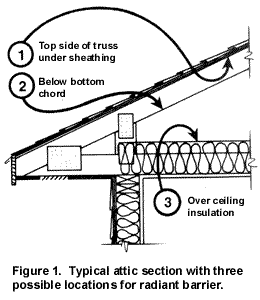 Radiant
barriers can be anything that is very reflective (has a very low emissivity.)
A good example of a radiant barrier is aluminum cooking foil since it reflects
heat
Radiant
barriers can be anything that is very reflective (has a very low emissivity.)
A good example of a radiant barrier is aluminum cooking foil since it reflects
heat 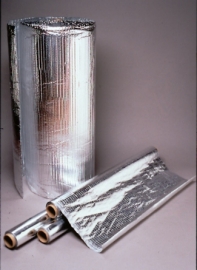 into
or away from food while cooking. Since the 1930s (which is about when aluminum
foil was invented) radiant barrier materials have proven themselves to
be a potentially effective method of keeping unwanted heat out of buildings
too. They are predominantly beneficial for buildings in cooling dominated
climates.
into
or away from food while cooking. Since the 1930s (which is about when aluminum
foil was invented) radiant barrier materials have proven themselves to
be a potentially effective method of keeping unwanted heat out of buildings
too. They are predominantly beneficial for buildings in cooling dominated
climates.
Unlike the more common types of insulation (i.e., fiberglass, cellulose,
etc. that trap pockets of a gas which in turn reduces heat conduction)
radiant barriers reduce only radiant heat transfer. A single layer of reflective
material, properly installed between the hotter roof deck and the attic
floor, may reduce radiant heat transfer to the attic by about 95%.
Radiant barriers used in buildings to reduce cooling needs are usually
installed directly under the roof to reduce heat gain from the sun. You
may also see recommendations to apply them directly over any other attic
floor insulation, however this strategy is NOT recommended since dust will
quickly cover the reflective surface and reduce the insulating effect significantly.
Radiant barriers are also very effective for walls that get direct sunlight
hitting them, and were building an effective roof overhang is not practical
(for example walls facing west.) However, unless you plan on rebuilding
the wall for another reason (or the cost of labor is nominal) this application
may be too expensive to have a reasonable economic payback in retrofit
situations.
It is also worth noting that research has proven that radiant barriers
installed in heating dominated climates are not economic at all unless
the material and labor costs are extremely low (almost free.) And, in some
cases, radiant barriers have been seen to actually increase heating costs
since the attic was kept cooler during sunny winter weather. This increased
heat loss from the living space below during those sunny daytime hours.
 ..
..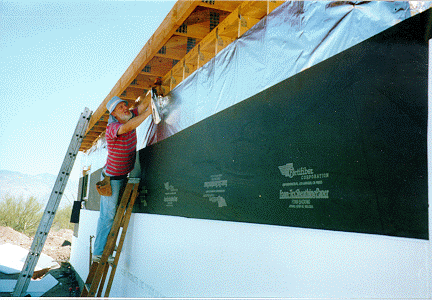 ..
..
every day examples of radiant barriers......................................................over
blackboard
How Radiant Barriers Work
Heat travels from a warm area to a cool area by a combination of conduction,
convection, and radiation. Heat flows by conduction from a hotter material
to a colder material when the two materials touch. Heat transfer by convection
occurs when a liquid or gas is heated, becomes less dense, and rises. Radiant
heat travels in a straight line away from the hot surface and heats anything
solid as the wave of energy hits it.
When the sun heats a roof, it is primarily the sunís radiant energy
that makes the roof hot. A large portion of this heat travels by conduction
through the roofing materials to the attic side of the roof. The hot roof
material then radiates itís gained heat energy into the cooler attic (some
of the roofís heat will radiate in other directions too.) A radiant barrier
reduces the radiant heat transfer from the roof to the attic space.
Some radiant barrier installations work better than others. The key
to understanding them is 1) the emissivity of the materialís surface; 2)
the temperature of the reflective surface and the surface temperature of
the source of the heat; 3) and the angle the heat hits the receiving surface.
Of these items, the angle the heat wave strikes the surface has the
most influence on how well any shiny surface acts as a thermal insulator.
All radiant barriers work best when heat hits the surface at a right angle
(perpendicular.) From one brand of radiant barrier to another, how shiny
the material is, and itís emissivity, is so similar that it makes little
difference as far as thermal performance. (Most products have emissivities
between 0.03 to 0.05, which is the same as a reflectivity of 97% to 95%.)
Also the greater the desired temperature difference between the sides of
the radiant barrier material, the greater the benefits a radiant barrier
can offer.
It may also be worth noting that a very glossy white paint is within
10% of as good reflector of heat as most of the common radiant barriers
currently available in residential construction.
Since insulation of any type is intended to keep heat from moving in
an undesired direction, the amount of thermal insulation already in the
attic affects the benefits a radiant barrier may have in energy savings.
For example, installing a radiant barrier in an attic that already has
at least the DOE minimum recommendation of attic insulation for that climate
will be less cost effective than an attic insulated to an inferior level.
It is also necessary that an air space be on at least one side of the reflecting
surface. If the material intended as a radiant barrier is "sandwiched"
between two other materials without the air space the insulating effect
from the foil surface is reduced to zero.
Selection
First determine if a radiant barrier is worthwhile for your climate.
As mentioned before, they are intended for very sunny, hot climates to
reduce cooling loads. Radiant barriers tend to offer little if any benefits
in Northern heating dominated climates. They are also of minor value if
your homeís roof is already heavily shaded by trees or has at least the
minimum insulation recommended for your climate.
Most radiant barrier materials on the market today have about the same
emissivity values. Therefore, you should consider other characteristics
(strength, flammability, availability, and cost) before you buy.
Resistance to tearing is important especially for the "do-it-yourself"
installation. A logical method for you to test its strength is to obtain
a sample and try to tear it by hand. A barrier that tears easily may rip
at fastening points and make installation difficult, if not impossible.
The types that are least susceptible to tearing usually have a woven mesh
laminated between two sheets of foil. Other types use a "bubble-pack" between
the foil faces. This is similar to the plastic sheets typically used to
cushion packages for shipping.
You should also check the flammability rating. Choose one that has a
Uniform Building Code (UBC) Class I, or National Fire Protection Association
(NFPA) Class A, flammability rating. If you are uncertain ask your local
fire department or building inspectors office about suitability of the
product you are considering.
Radiant barriers also direct heat back through the roofing materials
and may raise shingle temperatures 1° to 10° F (17.2° to 12.2°
C) but this has been proven to have no detrimental effects on roofing materials.
Since there is currently no standard method for equating how well a
radiant barrier works when comparing it to other insulation types, many
manufacturers use the term "equivalent R-value." Be wary of such claims
since this has no scientific or legal meaning, and manufacturersí claims
often reflect optimum conditions and not necessarily climate conditions
at your homesite.
Installation
There are a variety of installation options for radiant barriers: There
are rolled foil types, radiant barrier paints, metal shingles, and roof
sheathing that has a radiant barrier laminated to it. There is even aluminum
foil "chips" mixed with blown-in cellulose insulation. All of these work
in similar ways, but some types work a little better than others under
specific circumstances.
When installing a rolled foil barrier, the easiest way to install it
is during new construction. The installer typically drapes the radiant
barrier, foil-face down between the roof rafters to minimize dust accumulation
on the reflective faces (double-faced radiant barriers are available.)
This is generally done just before the roof sheathing goes on if itís not
too windy, but it can also be done afterwards from inside the attic by
stapling it to the bottom of the rafters.
When installing a foil-type barrier it is important to allow the material
to "droop" between the attachment points to make at least a 1.0 inch (2.5
cm) air space between it and the bottom of the roof. This air space has
mainly two functions: it creates an air channel for the soffit and ridge
ventilation system to work more effectively; and acts as a second reflector
since there are two shiny sides (one facing up/ one facing down.)
Some builders also try to attach the radiant barrier directly onto the
roof sheathing prior to their installation on the roof rafters, but a more
effective method is to simply buy foil-faced plywood sheathing instead.
There are also metal roof shingles that have a reflective underside. If
you needed roof shingles anyway, these are a practical option although
the cost of the material is considerably higher than other types of radiant
barriers.
As mentioned earlier, a radiant barrier on top of attic floor insulation
is more susceptible to dust accumulation. This undesirable method may also
trap moisture in the fiber insulation since, during cold weather, a radiant
barrier on the cold side of the insulation acts as a vapor barrier in the
wrong location. When warm moisture carrying house air leaks into the attic
in the winter, it may condense on the underside of the barrier. Even a
perforated radiant barrier can trap moisture in cold climates since the
water can freeze in the small holes and seal them. Because of these hazards
it is strongly recommend that you NOT apply radiant barriers directly on
top of the attic floor insulation. Of course, installing it at all in a
cold climate is not generally cost effective anyway.
How Effective are Radiant Barriers?
During the summer, an attic radiant barrier, combined with existing
R-19 attic insulation, will usually result in a total cooling load savings
of 2%-15%. Buildings with little to no attic insulation and more than the
usual amount of attic ventilation typically provides the most dramatic
energy savings from a radiant barrier. The hotter and sunnier the climate
is, the more beneficial the radiant barrier installation becomes. The reduced
heat gain may also allow you to install a smaller air conditioning system,
which results in even more saved energy.
For buildings in heating dominated climates (and with poor insulation
on the attic floor) it is generally far more cost effective to install
more than the minimum recommendation of ordinary insulation rather than
a radiant barrier. This is because attics are often vented to the outdoors
and heat entering the attic in the winter (through the inferior floor insulation)
simply leaves the building through the attic vents whether or not a radiant
barrier is present.
Also, in cold climates air conditioning is usually a much lower priority
than heating. Cold-climate homes also tend to have higher attic insulation
levels when compared to more Southern climates. As mentioned before, large
amounts of common attic insulation negates much of the usefulness of a
radiant barrier even under favorable circumstances.
Two field tests, one in Minnesota and one in Canada, both found that
a radiant barrier placed over R-19 attic floor insulation (which is less
than half the DOE minimum recommendation for those climates,) found that
the radiant barrier contributed to less than a 1% reduction in energy consumption
for heating and cooling.
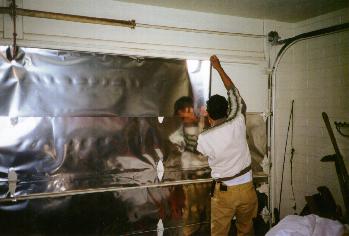 ..
..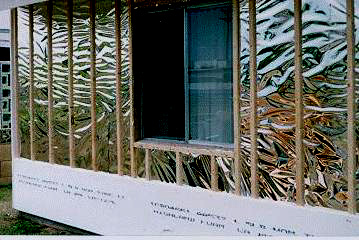
garage door barrier.......................between studs before cover
layer
..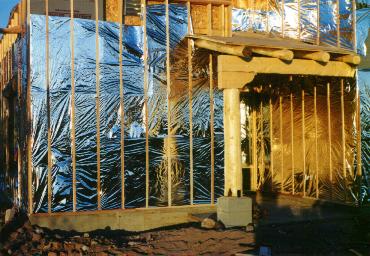 ..
..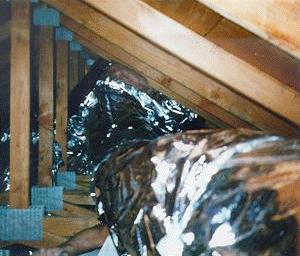 ..
..
between studs before cover layer....................................duct
wrap
..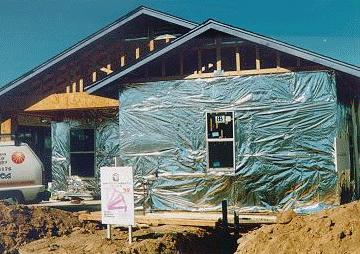
over blackboard
mailto: energy-resources@tell#&me1st.net
The above addresss is NOT correct. For security reasons, the
"#&" characters must be removed to be a correct address. This
reduces the possibility of a hacker autosearching for address links.
Simply copy and paste this address in your mail program, BUT remember
to delete the "#&" characters.
goto top.....r: 200301b
 Radiant
barriers can be anything that is very reflective (has a very low emissivity.)
A good example of a radiant barrier is aluminum cooking foil since it reflects
heat
Radiant
barriers can be anything that is very reflective (has a very low emissivity.)
A good example of a radiant barrier is aluminum cooking foil since it reflects
heat  into
or away from food while cooking. Since the 1930s (which is about when aluminum
foil was invented) radiant barrier materials have proven themselves to
be a potentially effective method of keeping unwanted heat out of buildings
too. They are predominantly beneficial for buildings in cooling dominated
climates.
into
or away from food while cooking. Since the 1930s (which is about when aluminum
foil was invented) radiant barrier materials have proven themselves to
be a potentially effective method of keeping unwanted heat out of buildings
too. They are predominantly beneficial for buildings in cooling dominated
climates.
 ..
.. ..
..
 ..
..
 ..
.. ..
..
